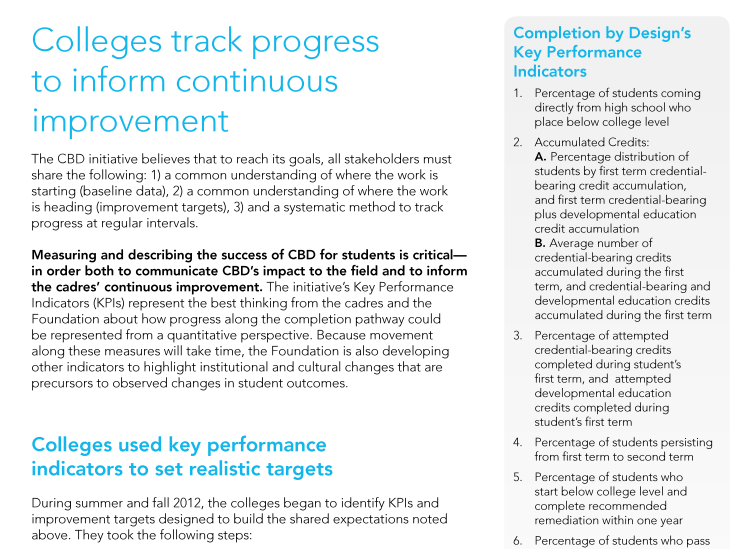Colleges Track Progress to Inform Continuous Improvement
Key Performance Indicators (KPIs)
Publication Date: 2012
Format: Brief (PDF)

This one-page brief outlines the rationale for identifying and tracking Key Performance Indicators (KPIs) as part of the Completion by Design initiative. It summarizes the 11 agreed-upon KPIs that participating colleges used to monitor student success and describes the four-step process they followed to set realistic, context-specific targets. The resource offers a clear snapshot of how institutions can use shared metrics to support improvement, enhance cross-campus collaboration, and maintain focus on student outcomes throughout a reform effort.
Connections to the Transformation Journey
and How Institutions Transform
Stages of Transformation
- Sharpen the Focus: This brief supports institutions in the Sharpen the Focus stage by outlining a practical, structured approach to setting performance targets. While situated in the context of a grant initiative, it offers strong rationale for why target setting is a critical component of institutional change and presents 11 KPIs that may be broadly relevant to transformation efforts.
Learn more about the Transformation Journey and How Institutions Transform.
Core Institutional Capacities
- Catalytic Leadership: This resource can help strengthen an institution’s catalytic leadership capacity by reinforcing the importance of shared understanding around where efforts are headed (improvement targets) and why a more methodical, transparent process for setting those targets matters. It supports leaders in articulating a clear direction for student success efforts and leading institutional change with clarity and purpose.
- Strategic Data Use: This resource also supports strategic data use by emphasizing the value of understanding where efforts started (baseline data), where they’re going (targets), and how progress is tracked over time. It offers compelling language in support of using data to guide decisions—reinforcing the call for evidence-based practices and helping explain a process that can often feel political or arbitrary.
Learn more about the Transformation Journey and How Institutions Transform.
Continuous Improvement
This resource is most relevant to the following cross-functional roles:
- Senior Leaders: This brief is particularly useful for senior leaders seeking a methodical, transparent approach to performance goal-setting. It advocates for institutional clarity and shared ownership over key metrics that drive transformation.
This resource connects to the following phase(s) of the PRPAM framework:
- Prioritize: This resource aligns directly with the Prioritize phase of a continuous improvement cycle. It supports institutions in identifying what to measure, setting meaningful targets, and establishing clear benchmarks to guide and evaluate transformation efforts.
Learn more about the Transformation Journey and How Institutions Transform.
Stages of Transformation
- Sharpen the Focus: This brief supports institutions in the Sharpen the Focus stage by outlining a practical, structured approach to setting performance targets. While situated in the context of a grant initiative, it offers strong rationale for why target setting is a critical component of institutional change and presents 11 KPIs that may be broadly relevant to transformation efforts.
Learn more about the Transformation Journey and How Institutions Transform.
Core Institutional Capacities
- Catalytic Leadership: This resource can help strengthen an institution’s catalytic leadership capacity by reinforcing the importance of shared understanding around where efforts are headed (improvement targets) and why a more methodical, transparent process for setting those targets matters. It supports leaders in articulating a clear direction for student success efforts and leading institutional change with clarity and purpose.
- Strategic Data Use: This resource also supports strategic data use by emphasizing the value of understanding where efforts started (baseline data), where they’re going (targets), and how progress is tracked over time. It offers compelling language in support of using data to guide decisions—reinforcing the call for evidence-based practices and helping explain a process that can often feel political or arbitrary.
Learn more about the Transformation Journey and How Institutions Transform.
Continuous Improvement
This resource is most relevant to the following cross-functional roles:
- Senior Leaders: This brief is particularly useful for senior leaders seeking a methodical, transparent approach to performance goal-setting. It advocates for institutional clarity and shared ownership over key metrics that drive transformation.
This resource connects to the following phase(s) of the PRPAM framework:
- Prioritize: This resource aligns directly with the Prioritize phase of a continuous improvement cycle. It supports institutions in identifying what to measure, setting meaningful targets, and establishing clear benchmarks to guide and evaluate transformation efforts.
Learn more about the Transformation Journey and How Institutions Transform.
Recommended Citation: Completion By Design. (2012). Colleges track progress to inform continuous improvement.


